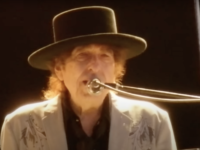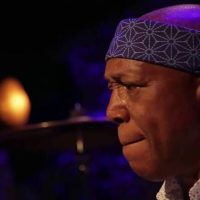At Riverside Theater, Milwaukee, Wisconsin: Wednesday night’s Bob Dylan concert was as meticulously crafted as a classical music program by the Milwaukee Symphony. Long known for altering his set list from night to night, Dylan now presents an unchanging program of songs, no matter the location.
A Texas friend of mine saw this tour last week. He felt certain that Bob would acknowledge his surroundings by performing “If You Ever Go to Houston.” Nope. Even when in his old stomping grounds of Minneapolis/St. Paul, Bob Dylan gives no special nods to location. The set lists for the three nights he played there last fall were identical to each other, and to the rest of the tour.
What does this tell us? That this artist wants his audience to hear these songs in this order, the great majority of which come from his newer releases. “Things Have Changed” opens the evening, clearly announcing that listeners should abandon all expectations of a greatest hits review. There will be no “Lay, Lady, Lay,” “All Along the Watchtower,” or “Like a Rolling Stone” tonight.
But to my surprise, the sold-out Riverside Theater audience seemed fine with this. An occasional shout would come from the crowd, but the most discernible yell was not for an old song, but was an early Happy Birthday greeting. In his most recent interview, Dylan talked about how his younger audience is far more accepting of his current concerts, stating that many of his early fans are now locked in a music “time warp.” Based on the enthusiasm shown by this tour’s audiences, Bob Dylan is an accurate judge of his fan base.
A few old songs did surface. “Tangled Up in Blue” and “Simple Twist of Fate” came near the end of the first set and the start of the second, respectively. And when the audience recognized these numbers, certainly they were pleased. But there was no sense of, “At last; this is what we came for!” In fact, reactions nearly as strong greeted the start of “Pay in Blood,” “Forgetful Heart,” and “Duquesne Whistle.”
Dylan seemed especially intent on having the audience absorb his lyrics. Gone was the muddy sound that has sometimes marred his shows. I am convinced that the improved fidelity was not simply a happy accident of this specific evening. To insure sound clarity, bassist Tony Garnier played guitar as often as he played either his acoustic or electric bass. The crisp sound was also helped by drummer George Recile’s light use of brushes on several numbers. Any rhythm that might have been needed to accentuate the understated bass and drums instrumentation was always present in Stu Kimball’s solid guitar work.
As for Dylan, he no longer plays guitar at all. Piano has become his primary instrument. Bob Dylan split his time between a baby grand and center stage, where both a modern and an old-time ribbon microphone stood. Unlike concerts of a decade ago, the piano is now clearly present in the sound mix, and there is no secondary keyboard in the band. Dylan occasionally played rudimentary piano on his early albums, but now he seems very comfortable with the instrument.
Donnie Herron is Dylan’s utility man. He rapidly switches between a wide variety of string instruments, and is strategically located on a raised platform near Dylan. It was interesting to observe Herron as he intently watched Bob’s hands on the piano keys, making sure that his string part would fit exactly with what Bob Dylan was playing.
In addition to piano, Dylan still plays harmonica. These harp interludes invariably drew enthusiastic responses. Bob selected his harmonica for a given song from a wooden box near the piano. Lined with green fabric, it was placed below a bust that appeared to be of Mozart. While this perhaps sounds pretentious, it actually fit well with the comfortable stage ambience. The lighting was not dim, but rather subdued, placing focus onto the songs being performed. Some lovely lighting elements occasionally adorned the dark curtain that draped the entire rear of the stage. These were usually vertical shafts of golden light; static forms, as opposed to disruptive light shows or recognizable images.
As the evening’s program unfolded, only once did I think Dylan might be calling up a tune that the band was not expecting. Late in the second set, Dylan said something to lead guitarist Charlie Sexton. Sexton immediately removed the electric guitar he had just put on and quickly strapped on an acoustic. Even within a rigid set list, Bob Dylan is still experimenting with different musical variables.
Dylan had been moving between the piano and center stage all night, often strolling the length of the performance space as the band played. But during the chords that linked the beautiful “Long and Wasted Years” with the final song of the main set, Dylan stopped by the drum platform and stretched repeatedly. He then walked to the microphone and sang “Autumn Leaves.” His gravelled voice was a perfect match for this song of longing and remembrance.
The two numbers performed for the encore, like the entire program, were carefully selected. The first was a beautiful version of “Blowin’ in the Wind.” More than a closing crowd pleaser or a reminder of his origins, Bob Dylan may have been demonstrating the continued relevance of this song. Like Hal Holbrook’s recent Milwaukee performance that channeled the frighteningly timely political views of Mark Twain, Dylan’s words still glow like burning coal.
The final selection presented each night of this tour is “Stay With Me.” Perhaps Bob is using the theme of this last song as a thank you to his audience for remaining loyal to him during his lengthy career. It could also be heard as a hope that they continue to listen. Maybe those stretches he did before “Autumn Leaves” suggest that Bob Dylan is only now getting warmed up.
- Dickey Betts’ Star Rose as the Allman Brothers Band Grieved - April 19, 2024
- ‘Drums & Demons: The Tragic Journey of Jim Gordon,’ by Joel Selvin (2024): Books - March 12, 2024
- Robby Krieger – ‘Robby Krieger and the Soul Savages’ (2024) - February 26, 2024




